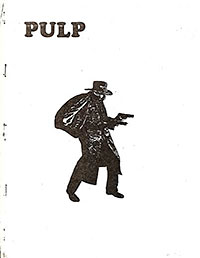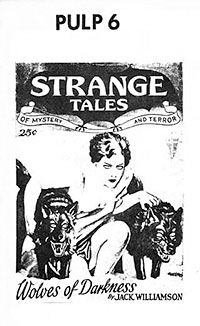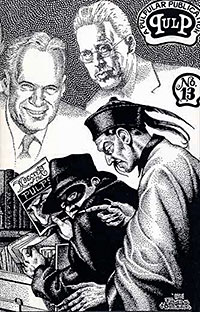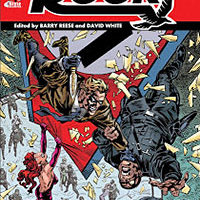 Pulp was a hero-pulp fanzine that was published from 1970-81.
Pulp was a hero-pulp fanzine that was published from 1970-81.
It basically had two phases. It was first published by Joel Frieman thru his “Pulp Press” in a 8.5×11 size for five issues. Then he turned it over to Robert Weinberg who published it until issue #13. During this period it was shrunk to 5×8 size, which matched the size of the various reprint series Weinberg was doing at the time. Also, he reprinted a pulp story in each issue starting with #7.
While I now have a near complete run of the ‘zine, thanks to Michael Ingalls and Donna Littlefield having info on the ones I’m missing for earlier version of this posting.
#1 (Fall 1970). In this issue we get a collection of articles and checklists. Nick Carr provides an overview article on Operator #5, which includes discussion of all the stories in the Purple Invasion series. We have a short article on Dusty Ayres, along with a checklist. And a standalone checklist of Dan Fowler novels from G-Men. Finally, we get an article that looks at Theodore Tinsley‘s The Shadow novels, plus a check list of those.
#2 (Spring 1971). We start off this issue with an article by Robert Sampson on the 48 Doc Savage digests. Next is a checklist of G-77. Then we get an article on Philip Strange, the air-war pulp hero (now being reprinted by Age of Aces). A short article on Jerry Wade, the Candid Camera Kid, is next, along with a check-list of his stories as well as the Crimson Mask stories, which appeared in the same magazine, Detective Novels. Nick Carr provides an article on Ki-Gor, a jungle hero in the mode of Tarzan. And we get a checklist of all the Moon Man stories.
#3 (Summer of 1971). This issue proclaims it to be a “division” of Pulp Press. I’m not sure who is Pulp Press other than Joel Frieman and Robert Weinberg, or what else they published beyond “Hades & Hocus Pocus.” The bulk of this issue is taken up by an extensive article on Captain Future, with information taken from Edmond Hamilton. The other article is on The Shadow’s earlier life by Frank Eisgruber Jr., the first of two that will lead to his “Gangland’s Doom,” which came later from Weinberg.
#4 (Spring 1972). This issue focused on villains. Nick Carr provides an article on G-8 vs. his foe Chu Lung, and another on Emperor Rudolph of the Purple Invasion series. Frank Eisgruber Jr. has another article on The Shadow, this time looking at stories that had a hidden schemer, such as a spy or secret group or villain. We get a couple of short articles on the Secret Six and the villain Mr. Death from the Captain Babyface series in Dare-Devil Aces. Robert Sampson looks at Doc Savage villain John Sunlight, and Robert Weinberg looks at The Spider‘s foe The Living Pharaoh.
 #5 (Winter 1973). Under a reprint of a cover from Ghost Super-Detective, which ties to an article on this character by Robert Sampson, we get three more articles. We have an exchange between Walter Gibson and Nick Carr on The Shadow. Nick Carr has an article on the Avenger’s aides. Finally an article, author unknown, on Alias Mr Death, which I’ve reviewed.
#5 (Winter 1973). Under a reprint of a cover from Ghost Super-Detective, which ties to an article on this character by Robert Sampson, we get three more articles. We have an exchange between Walter Gibson and Nick Carr on The Shadow. Nick Carr has an article on the Avenger’s aides. Finally an article, author unknown, on Alias Mr Death, which I’ve reviewed.
#5 1/2 (July 1973). Pulpcon Special issue. Don’t have, which is my final need.
#6 (Winter 1974). We get an article by Norvell Page on how he writes from 1935. From Nick Carr we get an article on G-8 and Stahlmaske. There is a gallery of pulp covers, sadly in black and white and not well reproduced. Interestingly, we get a several Captain Future covers from Japan. There is also the beginning of a Talbot Mundy bibliography.
#7 (Spring 1975). With a Frank Hamilton cover, the focus is on The Whisperer with a great overview article by Will Murray and short story, “The Ghost of Lin San Fu” that ran in The Shadow for Nov. 1, 1938. This story would be reprinted in Sanctum Books‘ Shadow #56.
#8 (Spring 1976). This one gives us the first of the later Avenger short stories, “Death to The Avenger” that wouldn’t be reprinted again until Sanctum Books’ Avenger series. Also an article on The Masked Detective by Tom Johnson and another on the South Seas Stories pulp.
#9 (Summer 1976). Resumes The Avenger short story reprints with the second one, “A Coffin for the Avenger.” We also get a short article on Secret Agent X by Tom Johnson done as a dossier on him, along with a selection of SAX covers.
#10 (Winter 1978). A Frank Hamilton cover of The Avenger and Smitty graced this issue, along with the third Avenger short story, “Vengeance on the Avenger.” There is an interview with Abe Goodman by Weinberg, who was the younger brother of pulp publisher Martin Goodman and speaks of his time working on Goodman’s Red Circle pulps, and an article on The Phantom Fed by Tom Johnson.
#11 (Fall 1978). This issue has two articles in addition to the next Avenger short story, “Calling Justice Inc.” The first article by Nick Carr is on the deadly female agents that Operator #5 faced. The second is a short item on Bill Barnes that was written to be used in Pulp Classics #18, which would have reprinted a Bill Barnes story. But this didn’t happen when they found out Conde Nast didn’t own Bill Barnes, the rights had been sold off years ago to Peterson Publications. Who knows where the rights stand today.
#12 (Summer 1980). This issue is a western them with another Frank Hamilton cover, this time with Pete Rice. This has the fifth Avenger short story, “Cargo of Doom,” and an article by Nick Carr on the pulp westerns. We also get two short letters from a pair of pulp authors.
 #13 (Fall 1981). The final issue, which has a nice wrap around cover by Frank Hamilton. And thankfully they were able to get out the sixth and final Avenger short story, “To Find a Dead Man.” Several other items include an editorial which speaks of the sale of Popular Publications’s properties. As I understand it, the ownership of the company after Harry Steeger sold it in 1972 was to Brookside Publications. Later the assets were sold to Hachette. They then decided to sell off the assets around 1981. This was what lead to Joel Frieman creating Blazing Publications, later Argosy Communications in 1988, as the rights owner of the Popular Publication stories and characters. Popular kept all their records, as well as the records of the Munsey Co., which they later bought out. This material would be turned over to the New York Public Library for preservation. For pulp researchers, this is a treasure trove of information.
#13 (Fall 1981). The final issue, which has a nice wrap around cover by Frank Hamilton. And thankfully they were able to get out the sixth and final Avenger short story, “To Find a Dead Man.” Several other items include an editorial which speaks of the sale of Popular Publications’s properties. As I understand it, the ownership of the company after Harry Steeger sold it in 1972 was to Brookside Publications. Later the assets were sold to Hachette. They then decided to sell off the assets around 1981. This was what lead to Joel Frieman creating Blazing Publications, later Argosy Communications in 1988, as the rights owner of the Popular Publication stories and characters. Popular kept all their records, as well as the records of the Munsey Co., which they later bought out. This material would be turned over to the New York Public Library for preservation. For pulp researchers, this is a treasure trove of information.
Other articles include one on who wrote The Spider, based on research in the Popular Publications archives, and another on who wrote Operator #5. Both articles are accompanied by covers from those pulps.
I think that Pulp ended around the time that Weinberg’s various pulp reprint series also ended. Most likely it was just too costly to continue. Until the advent of print-on-demand, we wouldn’t see the amount of pulp reprints of this level for awhile.
(Updated 8/5/2015, 10/25/2018, 10/26/2019, 7/23/2023)




[…] Pulp Fanzines! […]